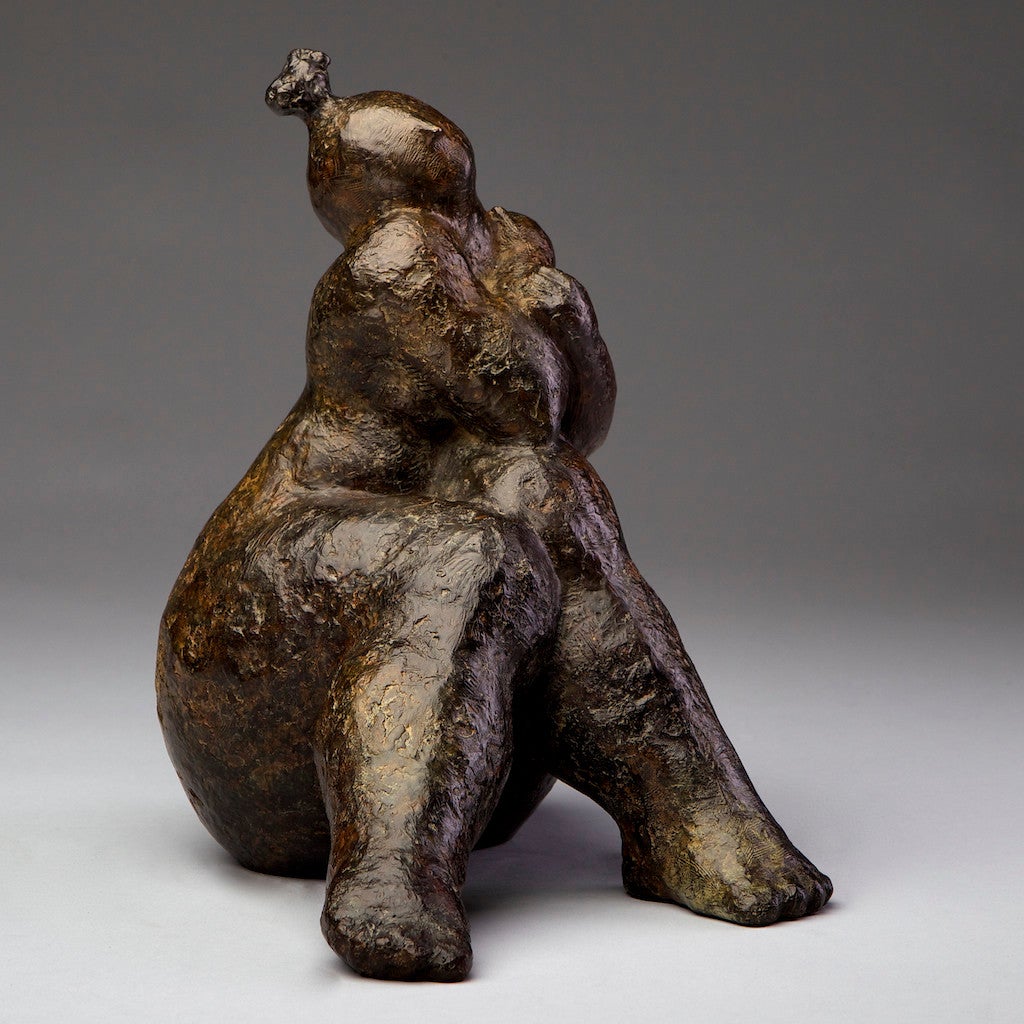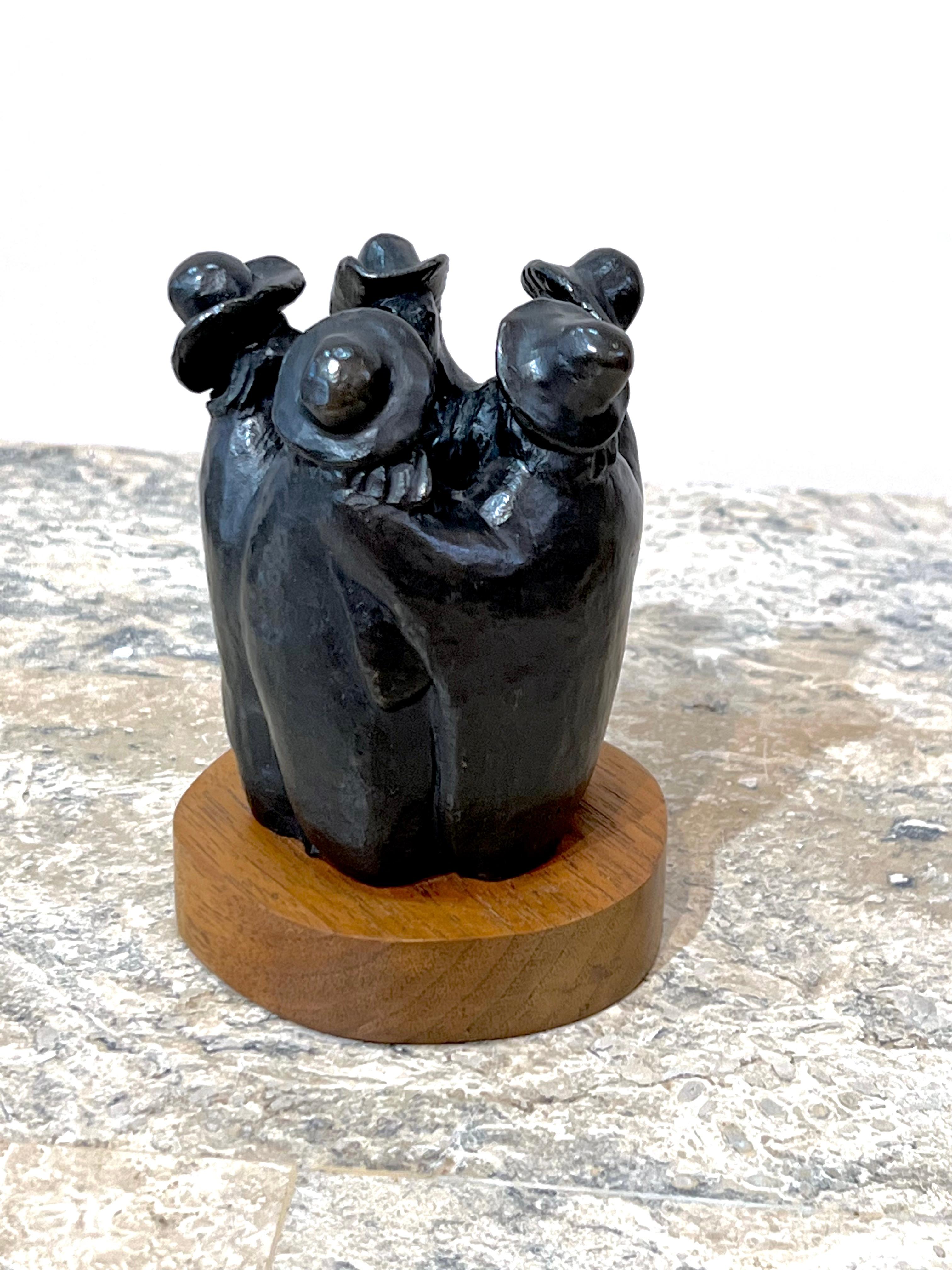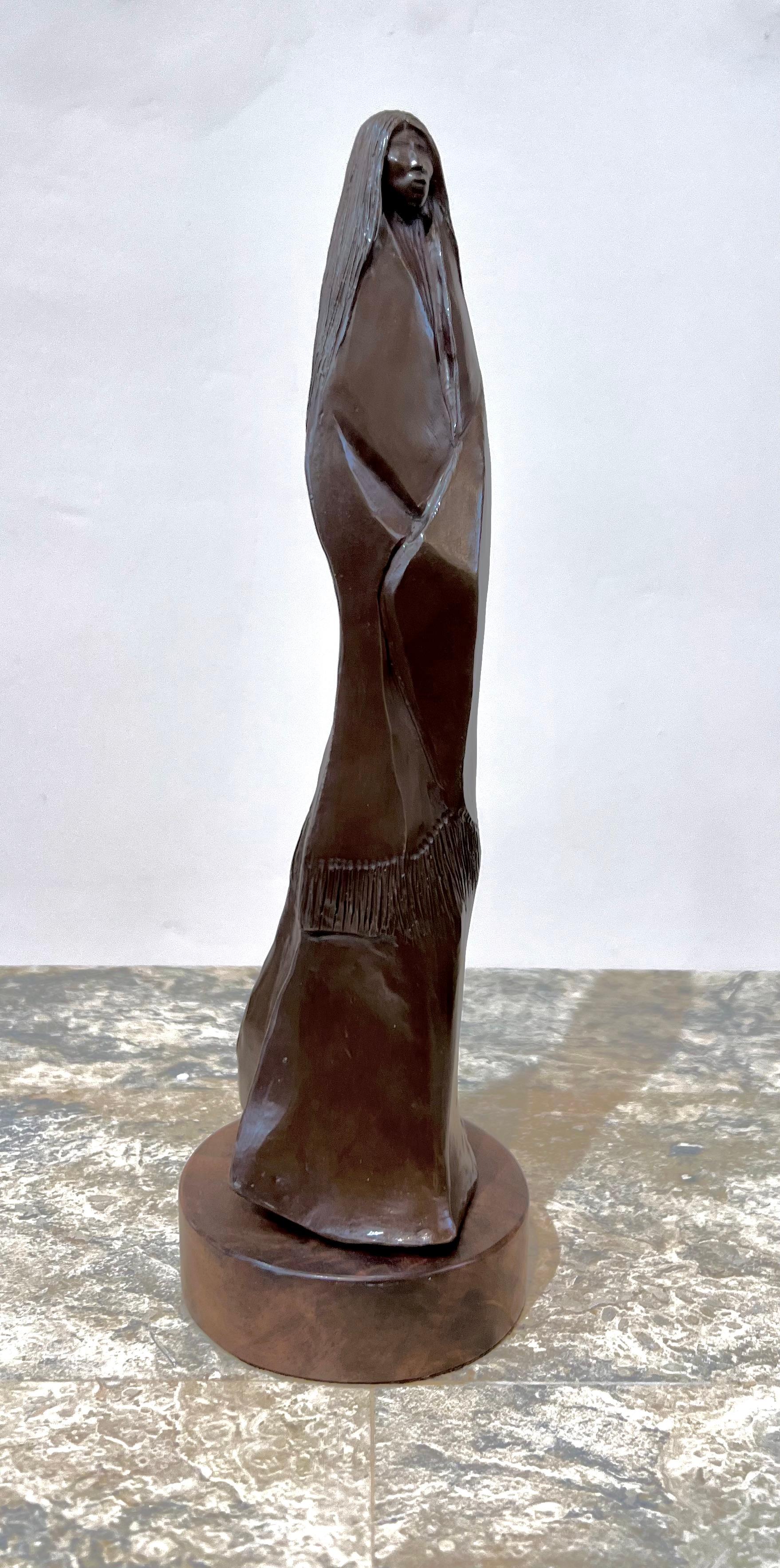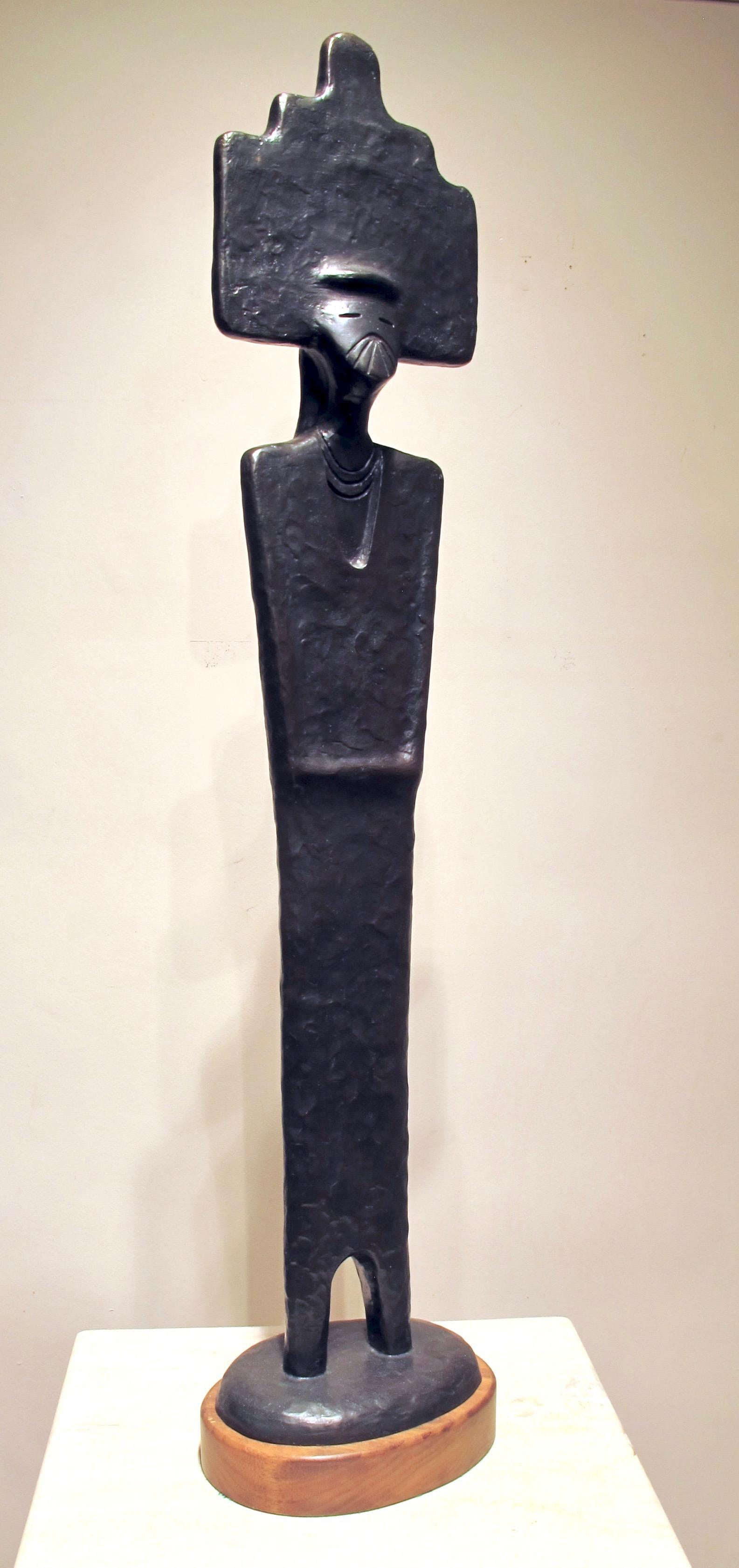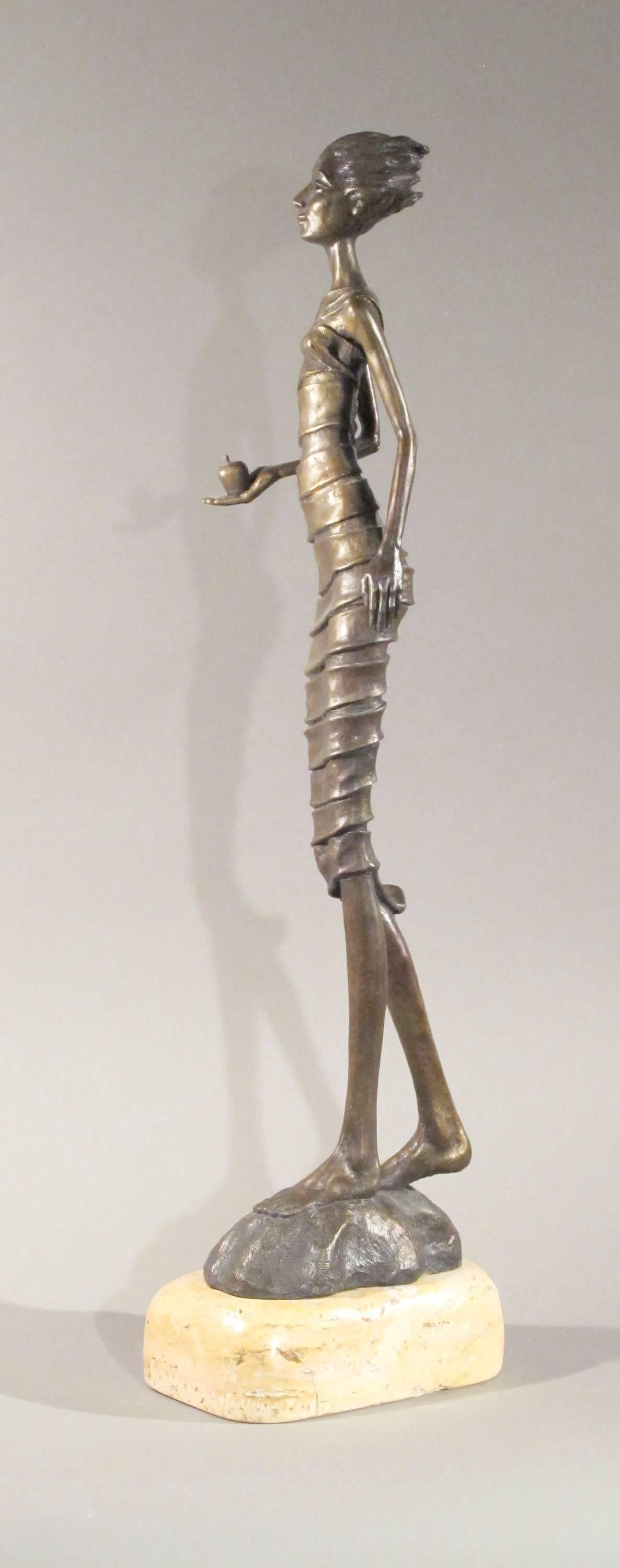Items Similar to ''La Baigneuse'', Contemporary Bronze Sculpture of an Elephant Sunbathing
Want more images or videos?
Request additional images or videos from the seller
1 of 12
Miep Maarse''La Baigneuse'', Contemporary Bronze Sculpture of an Elephant Sunbathing2016
2016
About the Item
The optimistic bronze sculptures of Dutch artist Miep Maarse (1945) are a feast for the eyes. Dancing elephants, bathing hippos and playing bears characterize her oeuvre. The images are optimistic in tone and message. Through her images she shows us her positive view of the world and humanity.
She shapes her sculptures in a professional and original way. The animals have recognizable human characteristics, which radiate great charm and tenderness. At first glance, this seems simple and charming. The opposite is true. You must have studied man and his behavior extremely well in order to make this translation. A hippopotamus - not a gentle animal at all - transforms into a friendly big lug who dances, dives or acts like an English lord. What is special is that Maarse finds her images so natural that people do not immediately realize that what they are actually doing is not possible.
In ''Between the Ears'' the mother elephant with her child between her ears looks so natural and realistic and is so moving and playful.
Almost casually, Miep Maarse asks the obligatory question: "How realistic is realistic?" Everyone will immediately admit that her images are not realistic. But what are they then? Surrealistic maybe? Strangely enough, it is obvious to place them in that movement, but everyone feels that something is not right. After all, with surrealism we immediately think of bizarre situations and alienation, while Miep Maarse's animal sculptures radiate something familiar and domestic.
Due to the metamorphosis that her animals undergo, they enter the realm of fabulous creatures. The animal sculptures are liberating because the depicted animals have different codes of conduct than the people who imitate them.
Miep Maarse received her education at the Gerrit Rietveld Academy in Amsterdam.
''La Baigneuse'' has an edition of 8.
- Creator:
- Creation Year:2016
- Dimensions:Height: 23.63 in (60 cm)Width: 13.78 in (35 cm)Depth: 9.45 in (24 cm)
- Medium:
- Movement & Style:
- Period:
- Condition:
- Gallery Location:Utrecht, NL
- Reference Number:
About the Seller
5.0
Vetted Seller
These experienced sellers undergo a comprehensive evaluation by our team of in-house experts.
Established in 1991
1stDibs seller since 2020
88 sales on 1stDibs
Typical response time: 1 hour
- ShippingRetrieving quote...Ships From: Utrecht, Netherlands
- Return PolicyA return for this item may be initiated within 3 days of delivery.
More From This SellerView All
- ''Love is the Message'' Bronze Sculpture of Astronaut with Heart BalloonBy Philipp LiehrLocated in Utrecht, NLGerman artist Philipp Liehr first discovered his extraordinary dexterity as a dental technician. He soon perfected this artistically as a cartoonist and during his training as a scul...Category
2010s Contemporary Figurative Sculptures
MaterialsBronze
- ''Night Owl" Contemporary Bronze Sculpture Portrait of an Owl, Barn OwlBy Anthony TheakstonLocated in Utrecht, NLBritish sculptor Anthony Theakston (1965), who draws his inspiration from the shape and movement of birds, simplifies the birds and omits more and more details until only the essence...Category
2010s Contemporary Figurative Sculptures
MaterialsBronze
- ''Miss Twiggy'', Contemporary Bronze Sculpture Portrait of a HareBy Ans ZondagLocated in Utrecht, NLAfter studying Fine Art in the Netherlands Ans Zondag (1959) spent several years abroad in order to explore different artistic areas and to establish which technique suited her best....Category
2010s Contemporary Figurative Sculptures
MaterialsBronze
- ''What do I Smell'' Contemporary Bronze Green Sculpture of a BearBy Karin BeekLocated in Utrecht, NLKarin Beek's (1948) bronze sculptures are characterized by a friendly, round and at the same time monumental style. They breathe the atmosphere of everyday life. Beek would like her ...Category
2010s Contemporary Figurative Sculptures
MaterialsBronze
- ''Sacred Langur 2'', Contemporary Bronze Sculpture of a Primate, MonkeyBy Nichola TheakstonLocated in Utrecht, NLNichola Theakston (1967) has established herself as one of the UK’s foremost contemporary sculptors working within the animal genre. Primates are Nichola's favorite subject. In her words: 'The notion that an individual creature may experience some ‘otherness’ or spiritual dimension beyond our understanding of its instinctive animal behaviors, is the premise behind much of my work, and portraiture a vehicle that I use to explore feeling and expression. Primates are an obvious and compelling choice of subject given their genetic proximity to human kind'. With the ''Sacred Langur...Category
2010s Contemporary Figurative Sculptures
MaterialsBronze
- ''Sitting Sow'', Contemporary Bronze Sculpture Portrait of a Sow, PigBy Ans ZondagLocated in Utrecht, NLAfter studying Fine Art in the Netherlands Ans Zondag (1959) spent several years abroad in order to explore different artistic areas and to establish which technique suited her best....Category
2010s Contemporary Figurative Sculptures
MaterialsBronze
You May Also Like
- "The Dreamer" Bronze sculpture of a rounded female figure sittingBy Monica WyattLocated in Edgartown, MAI first realized my love for visual storytelling when I began producing and directing television shows. Starting with the writer’s script, my palette was everything seen through the camera’s lens: actors, movement, light, and mood. Shot by shot, I wove together these images into two-dimensional dramas. I longed, however, to tell my own stories, to move beyond words and pictures, and to explore themes that ignited my imagination. My sculptures and assemblages became the three-dimensional stories I wanted to tell; stories about relationships, childhood, time passage, marriage, motherhood, and secrets never told. My sculpting process always begins with a tiny bit of clay to which I add more, never knowing how any piece will end. I don’t use models...Category
2010s Contemporary Figurative Sculptures
MaterialsBronze
- Somewhere on the Reservation, Bronze, Sculpture, Allan Houser, Apache, SingerBy Allan HouserLocated in Santa Fe, NMSomewhere on the Reservation, Bronze,Sculpture, by Allan Houser, Apache, Singers Allan Houser (Haozous), Chiricahua Apache 1914-1994 recipient of the National Medal of Arts in 1992. Allan Houser's father Sam, was part of the small band of Apaches who traveled with Geronimo and surrendered in southern Arizona in 1886. Allan's parents were imprisoned with that group in Ft. Sill, Oklahoma. He was the first child to be born in freedom to those Apaches and a fluent speaker of the Chiricahua language. Allan Houser is an important artist in that he is of the culture he depicts in his artwork. Allan's parents would tell stories and sing songs recalling the experiences on the warpath. Our gallery represented Allan Houser from 1974 until his passing in 1994 and were investors and provided quality control in the foundry process. Allan Houser's work is many international collections including the Georges Pompidou Centre, The Smithsonian National Portrait Gallery, The Dahlem Museum among others. Allan Houser (Haozous), Chiricahua Apache (1914-1994) Selected Collections Centre Georges Pompidou, Paris, France * “They’re Coming”, bronze Dahlem Museum, Berlin, Germany Japanese Royal Collection, Tokyo, Japan “The Eagle”, black marble commissioned by President William J. Clinton United States Mission to the United Nations, New York City, NY *"Offering of the Sacred Pipe”, monumental bronze by Allan Houser © 1979 Presented to the United States Mission to the United Nations as a symbol of World Peace honoring the native people of all tribes in these United States of America on February 27, 1985 by the families of Allan and Anna Marie Houser, George and Thelma Green and Glenn and Sandy Green in New York City. National Portrait Gallery, Smithsonian, Washington, DC * Portrait of Geronimo, bronze National Museum of American Art, Smithsonian, Washington, D.C. * “Buffalo Dance Relief”, Indiana limestone National Museum of the American Indian, Smithsonian, Washington, D.C. *Sacred Rain Arrow, (Originally dedicated at the US Senate Committee on Indian Affairs, US Senate Building) “Goat”, “To The Great Spirit” - dedicated in 1994 at the Vice President’s Residence in Washington, D.C.. Ceremony officiated by Hillary Rodham Clinton and Tipper Gore. Oklahoma State Capitol, Oklahoma City, Ok * “As Long As the Waters Flow”, bronze Gilcrease Museum, Tulsa, OK *Sacred Rain Arrow, bronze Fort Sill, Oklahoma *”Chiricahua Apache Family”, bronze Donated and dedicated to Allan Houser’s parents Sam and Blossom Haozous by Allan Houser and Glenn and Sandy Green The Heard Museum, Phoenix, Arizona *Earth Song, marble donated by Glenn and Sandy Green The Clinton Presidential Library, Arkansas * “May We Have Peace”, bronze The George H.W. Bush Presidential Library, College Station, Texas *"Offering to the Great Spirit", bronze The British Royal Collection, London, England *Princess Anne received "Proud Mother", bronze in Santa Fe Allan Houser’s father Sam Haozous, surrendered at the age of 14 with Geronimo and his band of Warm Springs Chiricahua Apache people in 1886 in Southern Arizona. This was the last active war party in the United States. This group of Apache people was imprisoned for 27 years starting in Fort Marion, Florida and finally living in captivity in Fort Sill, Oklahoma. Allan Houser was born in 1914. His artwork is an ongoing testimony to Native life in America – its beauty, strength and poignancy. Allan Houser is from the culture and portrayed his people in an insightful and authentic way. Because of the era in which he lived, he had a rare understanding of American Indian life. Allan was the first child born after the Chiricahua Apaches were released from 27 years of captivity. Allan grew up speaking the Chiricahua dialect. Allan heard his father’s stories of being on the warpath with Geronimo and almost nightly heard his parents singing traditional Apache music. Allan’s father knew all of Geronimo’s medicine songs. Allan had an early inclination to be artistic. He was exposed to many Apache ceremonial art forms: music, musical instruments, special dress, beadwork, body painting and dynamic dance that are integral aspects of his culture. His neighbors were members of many different tribes who lived in Oklahoma. Allan eagerly gained information about them and their cultures. Allan gathered this information and mentally stored images until he brought them back to life, years later, as a mature artist. Allan Houser was represented by Glenn Green Galleries (formerly known as The Gallery Wall, Inc.) from 1973 until his death in 1994. The gallery served as agents, advocates, and investors during this time. In 1973 the Greens responded enthusiastically to the abstraction and creativity in Houser’s work. They were impressed, not only with his versatility and talent but with the number of mediums he employed. His subject matter was portrayed in styles ranging from realism, stylized form to abstraction. With encouragement from the Greens, Houser at the age of 61, retired from his post as the head of the sculpture department at the Institute of American Indian Arts in Santa Fe, New Mexico in 1975 to begin working full-time creating his art. The next 20-year period was an exciting time for Allan, the gallery, and for the Green family. He created a large body of sculpture in stone, wood and bronze. For many years Glenn Green Galleries co-sponsored many editions of his bronzes and acted as quality control for the bronze sculptures according to Houser’s wishes. As both agents and gallery representatives, the Greens promoted and sold his art in their galleries in Phoenix and Scottsdale, Arizona and in Santa Fe, New Mexico. They had bi-annual exhibits in their galleries to feature Houser’s newest work and sponsored and arranged international museum shows in America, Europe and Asia. They travelled for these events including a trip to Carrara, Italy to the famed quarries of Michelangelo and together co-financed and arranged the purchase of 20 tons of marble. A watershed event for Allan Houser’s career occurred in the early 1980’s when Glenn Green Galleries arranged with the US Information Agency a touring exhibit of his sculpture through Europe. This series of exhibits drew record attendance for these museums and exposed Houser’s work to an enthusiastic art audience. This resulted in changing the perception of contemporary Native art in the United States where Houser and Glenn Green Galleries initially faced resistance from institutions who wanted to categorize him in a regional way. The credits from the European exhibits helped open doors and minds of the mainstream art community in the United States and beyond. Senator Daniel Inouye of Hawaii was a supporter of Allan Houser’s artwork. We worked with Senator Inouye on many occasions hosting events at our gallery and in Washington D.C in support of the formation of the Smithsonian’s National Museum of the American Indian in Washington, D.C. and other causes supporting Native Americans. Allan Houser is shown below presenting his sculpture “Swift Messenger” to Senator Inouye in Washington, D.C.. This sculpture was eventually given to the National Museum of the American Indian, Smithsonian’s permanent collection. It is now currently on loan and on display in the Oval Office. President Biden’s selection of artwork continues our gallery’s and Allan’s connection to the White House from our time working with Allan Houser from 1974 until his passing in 1994. “It was important for President Biden to walk into an Oval that looked like America and started to show the landscape of who he is going to be as president,” Ashley Williams...Category
1970s Contemporary Figurative Sculptures
MaterialsBronze
- San Carlos Girl, bronze, sculpture, by Allan Houser, Apache, woman, brownBy Allan HouserLocated in Santa Fe, NMSan Carlos Girl, bronze, sculpture, by Allan Houser, Apache, woman, brown lifetime casting limited edition Allan Houser (Haozous), Chiricahua Apache 1914-1994 recipient of the National Medal of Arts in 1992. Allan Houser's father Sam, was part of the small band of Apaches who traveled with Geronimo and surrendered in southern Arizona in 1886. Allan's parents were imprisoned with that group in Ft. Sill, Oklahoma. He was the first child to be born in freedom to those Apaches and a fluent speaker of the Chiricahua language. Allan Houser is an important artist because he is of the culture he depicts in his artwork. Allan's parents would tell stories and sing songs recalling the experiences on the warpath. Our gallery represented Allan Houser from 1974 until his passing in 1994 and were investors and provided quality control in the foundry process. Allan Houser's work is in many international collections including the Georges Pompidou Centre, The Smithsonian National Portrait Gallery, and The Dahlem Museum among others. Allan Houser (Haozous), Chiricahua Apache (1914-1994) Selected Collections Centre Georges Pompidou, Paris, France * “They’re Coming”, bronze Dahlem Museum, Berlin, Germany Japanese Royal Collection, Tokyo, Japan “The Eagle”, black marble commissioned by President William J. Clinton United States Mission to the United Nations, New York City, NY *"Offering of the Sacred Pipe”, monumental bronze by Allan Houser © 1979 Presented to the United States Mission to the United Nations as a symbol of World Peace honoring the native people of all tribes in these United States of America on February 27, 1985 by the families of Allan and Anna Marie Houser, George and Thelma Green and Glenn and Sandy Green in New York City. National Portrait Gallery, Smithsonian, Washington, DC * Portrait of Geronimo, bronze National Museum of American Art, Smithsonian, Washington, D.C. * “Buffalo Dance Relief”, Indiana limestone National Museum of the American Indian, Smithsonian, Washington, D.C. *Sacred Rain Arrow, (Originally dedicated at the US Senate Committee on Indian Affairs, US Senate Building) “Goat”, “To The Great Spirit” - dedicated in 1994 at the Vice President’s Residence in Washington, D.C.. The ceremony officiated by Hillary Rodham Clinton and Tipper Gore. Oklahoma State Capitol, Oklahoma City, Ok * “As Long As the Waters Flow”, bronze Gilcrease Museum, Tulsa, OK *Sacred Rain Arrow, bronze Fort Sill, Oklahoma *” Chiricahua Apache Family”, bronze Donated and dedicated to Allan Houser’s parents Sam and Blossom Haozous by Allan Houser and Glenn and Sandy Green The Heard Museum, Phoenix, Arizona *Earth Song, marble donated by Glenn and Sandy Green The Clinton Presidential Library, Arkansas * “May We Have Peace”, bronze The George H.W. Bush Presidential Library, College Station, Texas *"Offering to the Great Spirit", bronze The British Royal Collection, London, England *Princess Anne received "Proud Mother", bronze in Santa Fe Allan Houser’s father Sam Haozous, surrendered at the age of 14 with Geronimo and his band of Warm Springs Chiricahua Apache people in 1886 in Southern Arizona. This was the last active war party in the United States. This group of Apache people was imprisoned for 27 years starting in Fort Marion, Florida and finally living in captivity in Fort Sill, Oklahoma. Allan Houser was born in 1914. His artwork is an ongoing testimony to Native life in America – its beauty, strength and poignancy. Allan Houser is from the culture and portrayed his people in an insightful and authentic way. Because of the era in which he lived, he had a rare understanding of American Indian life. Allan was the first child born after the Chiricahua Apaches were released from 27 years of captivity. Allan grew up speaking the Chiricahua dialect. Allan heard his father’s stories of being on the warpath with Geronimo and almost nightly heard his parents singing traditional Apache music. Allan’s father knew all of Geronimo’s medicine songs. Allan had an early inclination to be artistic. He was exposed to many Apache ceremonial art forms: music, musical instruments, special dress, beadwork, body painting and dynamic dance that are integral aspects of his culture. His neighbors were members of many different tribes who lived in Oklahoma. Allan eagerly gained information about them and their cultures. Allan gathered this information and mentally stored images until he brought them back to life, years later, as a mature artist. Allan Houser was represented by Glenn Green Galleries (formerly known as The Gallery Wall, Inc.) from 1973 until his death in 1994. The gallery served as agents, advocates, and investors during this time. In 1973 the Greens responded enthusiastically to the abstraction and creativity in Houser’s work. They were impressed, not only with his versatility and talent but with the number of mediums he employed. His subject matter was portrayed in styles ranging from realism, stylized form to abstraction. With encouragement from the Greens, Houser at the age of 61, retired from his post as the head of the sculpture department at the Institute of American Indian Arts in Santa Fe, New Mexico in 1975 to begin working full-time creating his art. The next 20-year period was an exciting time for Allan, the gallery, and for the Green family. He created a large body of sculpture in stone, wood and bronze. For many years Glenn Green Galleries co-sponsored many editions of his bronzes and acted as quality control for the bronze sculptures according to Houser’s wishes. As both agents and gallery representatives, the Greens promoted and sold his art in their galleries in Phoenix and Scottsdale, Arizona and in Santa Fe, New Mexico. They had bi-annual exhibits in their galleries to feature Houser’s newest work and sponsored and arranged international museum shows in America, Europe and Asia. They travelled for these events including a trip to Carrara, Italy to the famed quarries of Michelangelo and together co-financed and arranged the purchase of 20 tons of marble. A watershed event for Allan Houser’s career occurred in the early 1980’s when Glenn Green Galleries arranged with the US Information Agency a touring exhibit of his sculpture through Europe. This series of exhibits drew record attendance for these museums and exposed Houser’s work to an enthusiastic art audience. This resulted in changing the perception of contemporary Native art in the United States where Houser and Glenn Green Galleries initially faced resistance from institutions who wanted to categorize him in a regional way. The credits from the European exhibits helped open doors and minds of the mainstream art community in the United States and beyond. Senator Daniel Inouye of Hawaii was a supporter of Allan Houser’s artwork. We worked with Senator Inouye on many occasions hosting events at our gallery and in Washington D.C in support of the formation of the Smithsonian’s National Museum of the American Indian in Washington, D.C. and other causes supporting Native Americans. Allan Houser is shown below presenting his sculpture “Swift Messenger” to Senator Inouye in Washington, D.C.. This sculpture was eventually given to the National Museum of the American Indian, Smithsonian’s permanent collection. It is now currently on loan and on display in the Oval Office. President Biden’s selection of artwork continues our gallery’s and Allan’s connection to the White House from our time working with Allan Houser from 1974 until his passing in 1994. “It was important for President Biden to walk into an Oval that looked like America and started to show the landscape of who he is going to be as president,” Ashley Williams...Category
1970s Contemporary Figurative Sculptures
MaterialsBronze
- Hesot Kachin Mana, by Dan Namingha, bronze, kachina, Hopi, brown, sculptureBy Dan NaminghaLocated in Santa Fe, NMHesot Kachin Mana, by Dan Namingha, bronze, kachina, Hop,i brown, sculpture #1/18 bronze edition signed and numbered by the artist We present paintings, prints, and sculptures by Sou...Category
1980s Contemporary Abstract Sculptures
MaterialsBronze
- First Bite, female figure holding apple, garden of eden, bronze sculpture WilliamsBy Troy WilliamsLocated in Santa Fe, NMFirst Bite,female figure holding apple,garden of eden,bronze sculpture Williams First Bite, female figure holding apple, garden of eden, bronze sculpture Expressing Situations and Beings in Human Form Sculptor Troy Williams unites the timeless and the contemporary in sculptures of rare beauty and meaning Beyond all the narrative potential of the three obvious physical dimensions of Troy Williams’ sculpture there are many other considerations that contribute greatly to the enjoyment, appreciation, and understanding of his entrancing 360-degree works of figurative art. Among these are the emotional responses and intellectual interpretations that first go into the artist’s creative process and then into every subsequent spectator’s viewings at least somewhat differently each time. Some artists insist on leaving these entirely up to each viewer, but Williams is glad to enrich the experience by inviting the viewer in for a little insight into the artist’s intention. Certain ambiguities and unintended provocations might otherwise arise, as Williams uses original combinations of materials or ideas in highly original ways. For the sophisticated clientele of Glenn Green Galleries Williams specializes in figurative and facial sculptures hewn from fallen woods he finds while running near his home in the mountains of north central New Mexico. Williams has in the past worked with exotic woods, but now avoids them in a desire to protect the people, plants, and animals that depend on a vibrant, healthy, and unexploited local ecosystems. Finding dead and downed wood also introduces an element of serendipitous chance into the sculptor’s process of selection and inspiration. Nature provides an exquisite mass of workable solids, surfaces, patterns, and curves in cottonwood and the many varieties of juniper this sculptor favors. Troy Williams simply rescues these from the elements and then elevates them to timeless treasures by relating them to themes that express our deepest nature. Awake to the most beautiful twists, turns, and striations already present in these found mediums, Williams is naturally and passionately drawn to every stage of freeing the underlying sculpture. Following the wood’s ingrained tendencies is always a creative guide for Williams. Growing up in an Indiana farming community, his dad a family practice doctor and his mother an artist, Troy has always felt an affinity for the earth and especially its mountains. He initially came west to study agriculture at Fort Lewis College in Durango, Colorado, attracted there by a setting where his athletic nature could find full expression. His interest in an agriculture career gave way to his love of the mountains. In order to continue living in them and enjoy the hiking, climbing, and running he also loved, Troy worked for several years in a solar business, progressing from manufacturing to installations to design. On a fortuitous errand for a cousin back home, Troy happened into silversmithing and began producing simple, hammered ear cuffs. At this point the artistic nature that he had earlier suppressed in favor of athletics began to emerge strongly, and he expanded into more complex designs as he learned and mastered goldsmithing and lapidary. Another quantum leap occurred when he made his first copper face for a pendant. He couldn’t wait to see the face on a larger scale and was eager for the challenge of learning another art. He began sculpting metal, then stone, then came upon wood as his medium of choice. Wood had immediate allure: scented, expanding, contracting, and seeming to breathe. Williams was seduced by its warmth, the play of light on the complexion of its grain, and the inherent life force so evident in wood. He also learned to coax creative advantage from some of wood’s pitfalls, like soft spots, tricky grains composed of woody xylem and softer phloem; and to avoid the conditions that make it splinter. A quality of segmentation or fragmentation characterizes Williams’s sculptures and provides great visual satisfaction along with intriguing thematic provocation. One is struck by the beautiful outlines that might never be apparent had Williams not removed segments or created interior voids expressly to reveal them. When sculpting a face, Williams focuses on aspects that are mask-like, floating, and alive with contours that might not be visible were the artist to sculpt the full head. The segmentation in his exquisitely refined female figurative works incorporates solids, hollows, and curvilinear elements for reasons that are at once artistic, philosophical, and experiential. Besides attending basic college art classes, to understand more fully the human figure, Troy spent a summer in Europe...Category
Early 2000s Contemporary Figurative Sculptures
MaterialsLimestone, Bronze
- After Botero - Horse with Saddle Bronze SculptureBy Fernando BoteroLocated in Cuauhtemoc, Ciudad de MéxicoAfter Fernando Botero Bronze HORSE WITH SADDLE - Sculpture on Marble Base Stamped F. BOTERO 1992, Numbered.Category
20th Century Contemporary Figurative Sculptures
MaterialsMarble, Bronze
Recently Viewed
View AllMore Ways To Browse
An Sculpture
Ear Sculpture
Bronze Of A Bear
Bronze Mother Sculpture
Bronze Elephant
Elephant Bronze
Bear Sculpture Bronze
Bronze Thinker
The Thinker Bronze
Bronze Sculpture Of A Bear
English Bronze Sculpture
Message Bronze
Dutch Bronze Sculptures
Mother Child Bronze
Bronze Mother And Child
Elephant Sculpture Bronze
Bronze Elephant Bronze Sculpture
Mother And Child Sculptures
